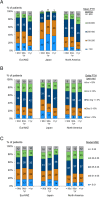Mineral and bone disorder management in hemodialysis patients: comparing PTH control practices in Japan with Europe and North America: the Dialysis Outcomes and Practice Patterns Study (DOPPS)
- PMID: 30290781
- PMCID: PMC6173912
- DOI: 10.1186/s12882-018-1056-5
Mineral and bone disorder management in hemodialysis patients: comparing PTH control practices in Japan with Europe and North America: the Dialysis Outcomes and Practice Patterns Study (DOPPS)
Abstract
Background: High-circulating level of parathyroid hormone (PTH) is associated with elevated mortality in dialysis patients. The Japanese Society for Dialysis Therapy guideline suggests a lower PTH target than other international guidelines; thus, PTH control may differ in Japan compared with other regions, and be associated with mortality.
Methods: We analyzed data from hemodialysis patients with ≥3 measurements of PTH during the first 9 months after enrollment in the Dialysis Outcomes and Practice Patterns Study (DOPPS) phases 4-5 (2009-2015). PTH control was assessed by the mean, slope, and mean squared error (MSE) of all PTH measurements over the 9-month run-in period. Distribution of each PTH control was assessed by regions (Europe/Australia/New Zealand [Eur/ANZ], Japan and North America) and dialysis vintage. Mortality rates were compared across PTH control categories using Cox regression models.
Results: Mean PTH was lower in Japan than in other regions across dialysis vintage categories. In patients with dialysis vintage < 90 days, PTH level was more likely to decline > 5% per month in Japan (48% of patients) versus Eur/ANZ (35%) and North America (35%). In patients with dialysis vintage > 1 year, Japanese patients maintained steady PTH, while patients in Eur/ANZ and North America were more likely to experience a PTH increase. Mean PTH was associated with mortality in the overall samples (highest mortality rate for PTH > 600 pg/mL, hazard ratio, 1.35; 95% confidence interval, 1.20 to 1.52 vs PTH 200-399 pg/mL), and the association was obvious in the prevalent patients (hazard ratio, 1.44; 95% confidence interval, 1.26 to 1.65). PTH slope and MSE did not show significant association with mortality in the overall sample as well as in subjects stratified both by region and dialysis vintage.
Conclusion: PTH control in hemodialysis patients, as measured by keeping a stable PTH level over 9 months, was observed in Japan contrasted with other regions. High PTH mean, but not increased PTH slope and MSE, was associated with mortality especially in prevalent patients.
Keywords: Dialysis outcomes and practice patterns study; Hemodialysis; Japanese society for Dialysis therapy; PTH slope; Parathyroid hormone.
Conflict of interest statement
Ethics approval and consent to participate
IRB approval was obtained from E&I West Coast Board on May 23, 2016, IRB # IRB00007807. Written, informed consent was obtained from participants.
Consent for publication
Not applicable.
Competing interests
S.Y. has received honoraria from Kyowa Hakko Kirin. H.K. has received honoraria, consulting fees, and/or grant/research support from Bayer Yakuhin and Kyowa Hakko Kirin. M.T. has received consulting fees from Kyowa Hakko Kirin. T.N. is an employee of Kyowa Hakko Kirin. M.F. has received honoraria, consulting fees, and/or grant/research support from Astellas Pharma, Bayer Yakuhin, Kyowa Hakko Kirin, Ono Pharmaceutical, and Torii Pharmaceutical. A.K., B.A.B., R.L.P., and B.M.R. are employees for the non-profit research organization Arbor Research Collaborative for Health, which has designed and carries out the Dialysis Outcomes and Practice Patterns Study (DOPPS) Program. Grants are made to Arbor Research Collaborative for Health and not to individual investigators. The remaining authors have no conflicts to report.
Publisher’s Note
Springer Nature remains neutral with regard to jurisdictional claims in published maps and institutional affiliations.
Figures


References
-
- Saran R, Robinson B, Abbott KC, Agodoa LYC, Bhave N, Bragg-Gresham J, Balkrishnan R, Dietrich X, Eckard A, Eggers PW, et al. US renal data system 2017 annual data report: epidemiology of kidney disease in the United States. Am J Kidney Dis. 2018;71(3S1):A7. doi: 10.1053/j.ajkd.2018.01.002. - DOI - PMC - PubMed
-
- Moe S, Drueke T, Cunningham J, Goodman W, Martin K, Olgaard K, Ott S, Sprague S, Lameire N, Eknoyan G, et al. Definition, evaluation, and classification of renal osteodystrophy: a position statement from kidney disease: improving global outcomes (KDIGO) Kidney Int. 2006;69(11):1945–1953. doi: 10.1038/sj.ki.5000414. - DOI - PubMed
-
- Tentori F, Wang M, Bieber BA, Karaboyas A, Li Y, Jacobson SH, Andreucci VE, Fukagawa M, Frimat L, Mendelssohn DC, et al. Recent changes in therapeutic approaches and association with outcomes among patients with secondary hyperparathyroidism on chronic hemodialysis: the DOPPS study. Clin J Am Soc Nephrol. 2015;10(1):98–109. doi: 10.2215/CJN.12941213. - DOI - PMC - PubMed
Publication types
MeSH terms
Substances
LinkOut - more resources
Full Text Sources
Medical

